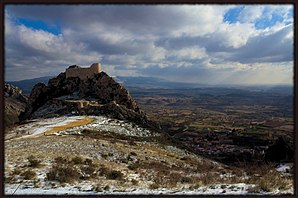Poza de la Sal
| Poza de la Sal municipality | ||
|---|---|---|
 Poza de la Sal - View of the town with the castle
|
||
| coat of arms | Map of Spain | |
 Help on coat of arms |
|
|
| Basic data | ||
| Autonomous Community : |
|
|
| Province : | Burgos | |
| Comarca : | La Bureba | |
| Coordinates | 42 ° 40 ′ N , 3 ° 30 ′ W | |
| Height : | 765 msnm | |
| Area : | 81.9 km² | |
| Residents : | 287 (Jan. 1, 2019) | |
| Population density : | 3.5 inhabitants / km² | |
| Postal code : | 09246 | |
| Municipality number ( INE ): | 09272 | |
| administration | ||
| Website : | Poza de la Sal | |
Poza de la Sal is a place and a municipality ( municipio ) with 287 inhabitants (as of January 1, 2019) in the north of the Spanish province of Burgos in the autonomous region of Castile-León . The entire town center is recognized as a cultural asset ( Bien de Interés Cultural ) in the Conjunto histórico-artístico category .
Location and climate
The place Poza de la Sal is located in the fertile region of the Bureba at an altitude of approx. 765 m . The provincial capital Burgos is located approx. 47 km (driving distance) southwest; the lovely town of Briviesca is a good 23 km southeast. The climate is temperate to warm; The rain, which is abundant by Spanish standards (approx. 735 mm / year) falls - with the exception of the summer months - over the year.
Population development
| year | 1857 | 1900 | 1950 | 2000 | 2017 |
| Residents | 2,447 | 1.952 | 1,318 | 384 | 303 |
As a result of the mechanization of agriculture , the abandonment of small farms and the resulting lack of jobs, the population of the community experienced a collapse in the middle of the 20th century. The municipality also includes the two hamlets (pedanías) Castil de Lences and Lences (de Bureba), each with around 40 inhabitants .
economy
From the Middle Ages to the first half of the 20th century, the place was the artisanal and mercantile center of several villages and individual farms in the area; the salt pans formed an important source of income . Today the cultivation of grain and livestock are important; Tourism in the form of renting holiday apartments is also an important source of income for the municipality.
history
The place was originally a settlement of the Celtic Autrigones and was then called Salionca ; the Romans also mined salt here. Visigothic and even Moorish traces are missing. At the end of the 9th and beginning of the 10th century, the Moors were pushed back into the areas south of the Duero ( reconquista ) under the leadership of the Castilian Counts Diego Rodríguez Porcelos (r. 873–885) and Fernán González ; thereafter a policy of repopulation ( repoblación ) was carried out in the areas north of the Duero . At the end of the 10th century, the Muslim military leader Almansor devastated the region for the last time. In the Middle Ages, the then small town received a castle (castillo) on a rock and was surrounded by a wall.
Attractions
- The ruins of the Castillo de los Rojas are perched on a rock high above the town. Parts of the medieval city wall (muralla) are still preserved.
- The three-aisled church of San Cosme y San Damián is a work of the 13th century; however, it received a new portal in the 17th century. The late baroque altarpiece (retablo) shows the two patron saints and other figures.
- Numerous half-timbered houses adorn the town center.
- The salt dome is one of the largest in Europe; the water is channeled through small aqueducts through the town to the saline basins located approx. 1 km to the northwest.
- Lences de Bureba
- The church in the village about 6 km to the south has a Romanesque origin, but it was later Gothicized. A south porch ( portico ) that protects the impressive Romanesque archivolt portal is rare that far north .
- Nearby, a single arched late medieval bridge with a raised apex crosses one of the region's many streams.
- Castil de Lences
- The Monasterio de la Asunción has medieval origins; the apse of the church and the cloister (claustro) date from the end of the 14th century, but most of the monastery buildings were modernized at a later date and the chapter house is spanned by an artesonado wooden ceiling.
- The simple church of the place is Romanesque.
Web links
- Poza de la Sal and surroundings, sights - photos + information (arteguias, Spanish)
Individual evidence
- ↑ Cifras oficiales de población resultantes de la revisión del Padrón municipal a 1 de enero . Population statistics from the Instituto Nacional de Estadística (population update).
- ↑ Poza de la Sal - climate tables
- ↑ Poza de la Sal - population development
- ↑ Poza de la Sal - castle and city wall
- ↑ Poza de la Sal - castle and city wall
- ↑ Poza de la Sal - Church





